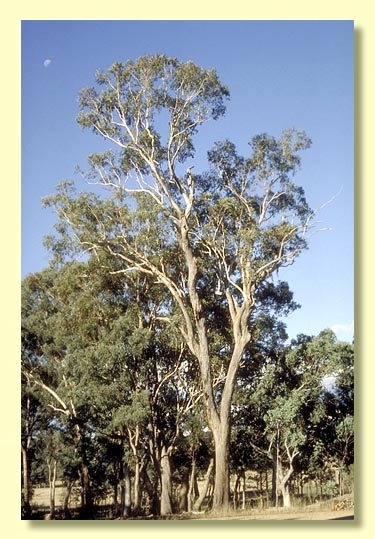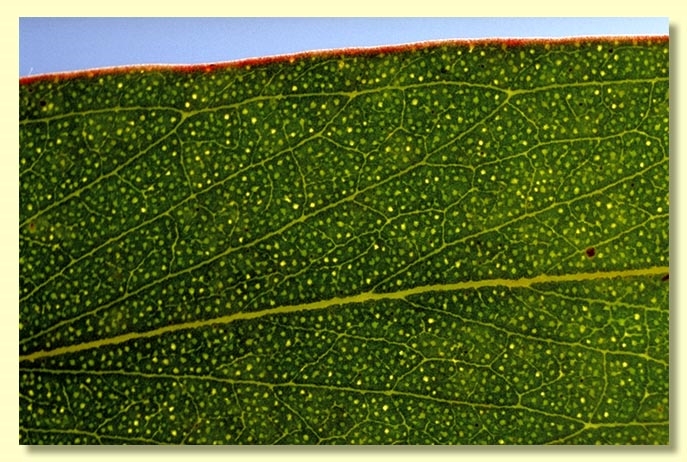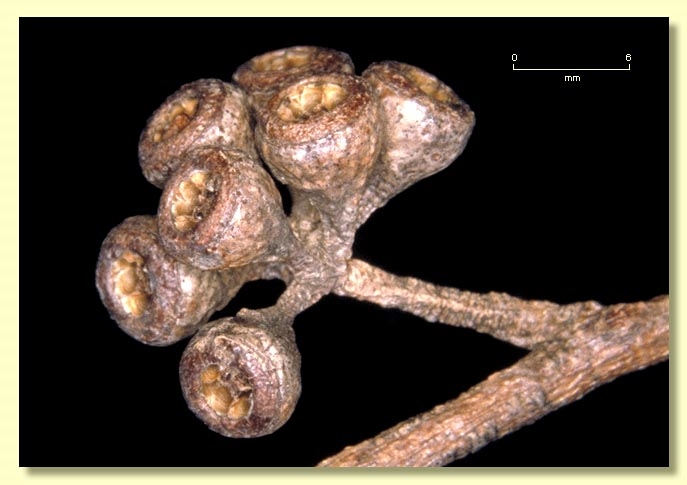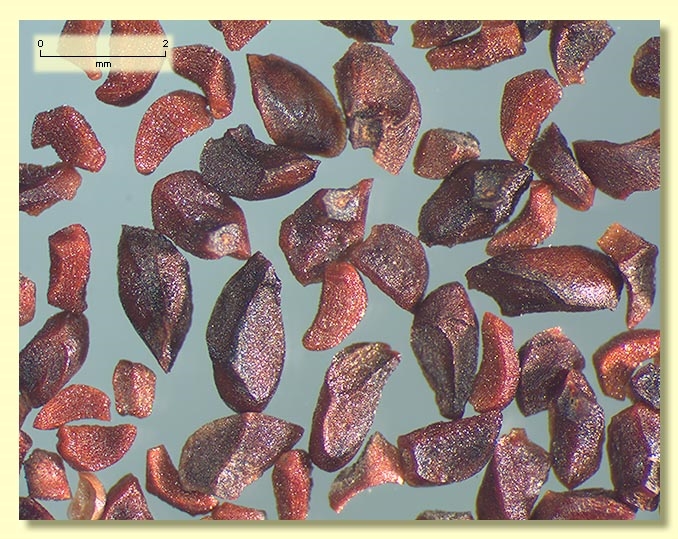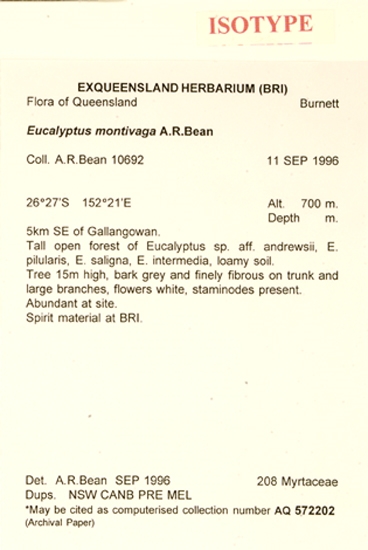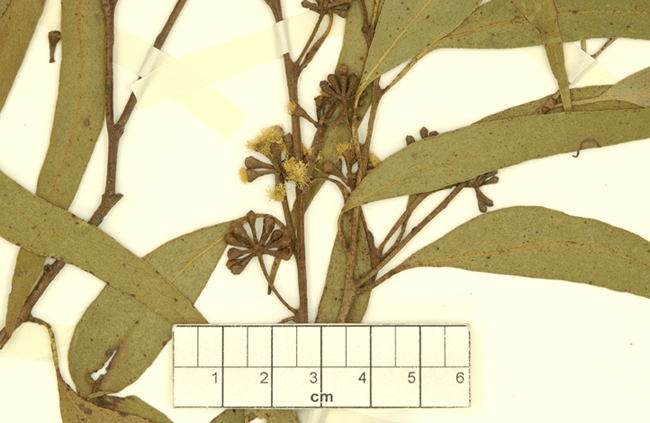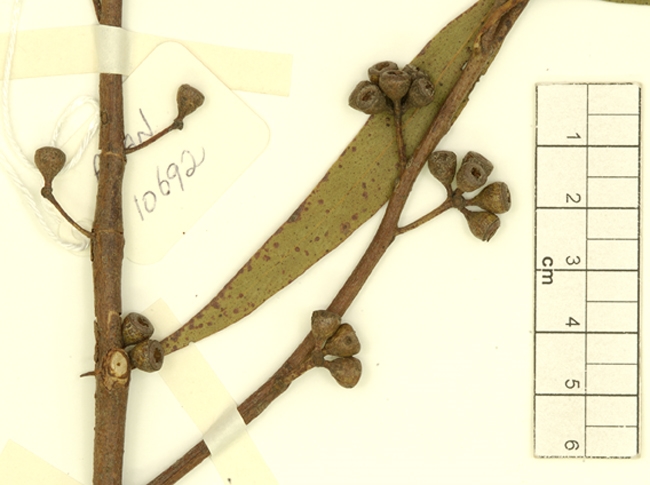Euclid - Online edition
Eucalyptus andrewsii subsp. andrewsii
Classification
Eucalyptus | Eucalyptus | Cineraceae | Psathyroxylon | Considenianae
Nomenclature
Eucalyptus andrewsii Maiden, Proc. Linn. Soc. New South Wales 2nd ser., 29: 472 (1904) subsp. andrewsii.
T: Tingha, NSW, 16 Oct. 1903, R.H.Cambage s.n.; lecto: NSW, fide J.H.Maiden, Crit. Revis. Eucalyptus 1: 195, 205 (1905).
E. haemastoma var. inophloia C.T.White, Queensland Agric. J. 2nd ser., 14: 70, t. 3 (1920). T: ranges near Toowoomba, Qld, C.T.White s.n.; herbarium of cited specimen not known to us.
T: Tingha, NSW, 16 Oct. 1903, R.H.Cambage s.n.; lecto: NSW, fide J.H.Maiden, Crit. Revis. Eucalyptus 1: 195, 205 (1905).
E. haemastoma var. inophloia C.T.White, Queensland Agric. J. 2nd ser., 14: 70, t. 3 (1920). T: ranges near Toowoomba, Qld, C.T.White s.n.; herbarium of cited specimen not known to us.
Description
Tree to 45 m tall. Forming a lignotuber.
Bark rough on trunk to base of large branches, finely fibrous (like peppermints), grey or grey-brown, smooth bark whitish.
Branchlets sometimes glaucous.
Juvenile growth (coppice or field seedlings to 50 cm): stem rounded in cross-section; juvenile leaves opposite, shortly petiolate and elliptical for ca 6 nodes then alternate, petiolate, ovate to lanceolate, becoming falcate, 4.5–10 cm long, 2.5–4.5 cm wide, base tapering or oblique, blue-green or grey-green.
Adult leaves alternate, petiole 1–2.5 cm long; blade lanceolate to falcate, 9–17 cm long, 1–3.2 cm wide, base oblique or tapering evenly to petiole, margin entire, concolorous, glossy or dull, green or slightly blue-green, side-veins acute, sparsely to moderately reticulate, intramarginal vein parallel to and well removed from margin, oil glands numerous, island.
Inflorescence axillary unbranched, peduncles 0.8–2 cm long, buds 11 to 15 per umbel, pedicels 0.4–0.5 cm long. Mature buds clavate, 0.3–0.4 cm long, 0.2–0.3 cm wide, yellowish tinged red, scar absent, operculum conical or rounded and apiculate, stamens inflexed, a few staminodes present or all stamens perfect, anthers reniform to cordate, versatile, dorsifixed, dehiscing by confluent slits, style short, locules 3 or 4(5) each with 2 vertical ovule rows. Flowers white.
Fruit on pedicels 0.3–0.6 cm long, cup-shaped or hemispherical, 0.4–0.6 cm long, 0.5–0.7 cm wide, disc slightly raised or level, valves 3 or 4(5), near rim level.
Seeds dark brown, 1–3 mm long, pyramidal or obliquely pyramidal, dorsal surface smooth, hilum terminal.
Cultivated seedlings (measured at ca node 10): cotyledons reniform; stems rounded in cross-section; leaves more or less sessile, opposite, discolorous, elliptic and held horizontally for lowest ca 6 nodes, then becoming petiolate, alternate, pendulous, lanceolate to falcate, 7–13 cm long, 2–5.2 cm wide, base oblique to tapering, grey-green throughout.
Bark rough on trunk to base of large branches, finely fibrous (like peppermints), grey or grey-brown, smooth bark whitish.
Branchlets sometimes glaucous.
Juvenile growth (coppice or field seedlings to 50 cm): stem rounded in cross-section; juvenile leaves opposite, shortly petiolate and elliptical for ca 6 nodes then alternate, petiolate, ovate to lanceolate, becoming falcate, 4.5–10 cm long, 2.5–4.5 cm wide, base tapering or oblique, blue-green or grey-green.
Adult leaves alternate, petiole 1–2.5 cm long; blade lanceolate to falcate, 9–17 cm long, 1–3.2 cm wide, base oblique or tapering evenly to petiole, margin entire, concolorous, glossy or dull, green or slightly blue-green, side-veins acute, sparsely to moderately reticulate, intramarginal vein parallel to and well removed from margin, oil glands numerous, island.
Inflorescence axillary unbranched, peduncles 0.8–2 cm long, buds 11 to 15 per umbel, pedicels 0.4–0.5 cm long. Mature buds clavate, 0.3–0.4 cm long, 0.2–0.3 cm wide, yellowish tinged red, scar absent, operculum conical or rounded and apiculate, stamens inflexed, a few staminodes present or all stamens perfect, anthers reniform to cordate, versatile, dorsifixed, dehiscing by confluent slits, style short, locules 3 or 4(5) each with 2 vertical ovule rows. Flowers white.
Fruit on pedicels 0.3–0.6 cm long, cup-shaped or hemispherical, 0.4–0.6 cm long, 0.5–0.7 cm wide, disc slightly raised or level, valves 3 or 4(5), near rim level.
Seeds dark brown, 1–3 mm long, pyramidal or obliquely pyramidal, dorsal surface smooth, hilum terminal.
Cultivated seedlings (measured at ca node 10): cotyledons reniform; stems rounded in cross-section; leaves more or less sessile, opposite, discolorous, elliptic and held horizontally for lowest ca 6 nodes, then becoming petiolate, alternate, pendulous, lanceolate to falcate, 7–13 cm long, 2–5.2 cm wide, base oblique to tapering, grey-green throughout.
Flowering Time
Flowering has been recorded in February, June, July and December.
Notes
Eucalyptus andrewsii is a small to tall tree species belonging to the blue-leaved ash group and occurs from the Northern Tablelands of New South Wales north sporadically to the vicinity of Eungella, west of Mackay in Queensland. It has grey peppermint-type bark and is easily recognisable in the field by the large, pendulous, alternating, broadly falcate, bluish green juvenile leaves of the regrowth particularly on roadsides.
There are two subspecies:
E. andrewsii subsp. andrewsii
Has a more or less hemipherical to cupular fruit and, in New South Wales, occurs mainly on the western side of the Northern Tablelands, extending into south-east Queensland on similar country, and further to the north with sporadic occurrences south-west of Gladstone, west of Maryborough and west of Mackay.
E. andrewsii subsp. campanulata
Occurs more on the eastern side of the Northern Tablelands, New South Wales and adjacent areas of far south-east Queensland. It has obconical to cupular fruit reminiscent of E. sieberi, of southern New South Wales, eastern Victoria and Tasmania. The bark of E. sieberi is, however, black and furrowed.
E. andrewsii belongs in Eucalyptus subgenus Eucalyptus section Cineraceae series Psathyroxylon and has the following characters: cotyledons reniform, juvenile leaves alternate, bluish, adult leaves with side-veins acute, single axillary inflorescences with buds in clusters of 11 to 15, buds with single operculum, inflexed stamens, some outer stamens without anthers (staminodes), the remainder with reniform anthers, style usually short, ovules in two rows, and seeds ± pyramidal. Within series Psathyroxylon, E. andrewsii is closely related to four other tree species, three with rough, finely fibrous bark on the trunks: E. consideniana, from southern New South Wales and eastern Victoria; E. remota, which is endemic to Kangaroo Island, South Australia; and E. olida, which occurs on the eastern side of the Northern Tablelands of New South Wales and can be distinguished by the unpleasant odour of the adult leaves and the long style. The fourth rough-barked species related to E. andrewsii is E. sieberi from southern New South Wales, eastern Victoria and Tasmania which has hard, blackish, furrowed, rough bark on the trunk. A fifth species in this group, E. multicaulis, is a mallee south from the Wollemi area of New South Wales to about Pigeon House Mountain and has little or no rough bark. These six species form subseries Considenianae.
In 1997 Tony Bean described E. montivaga from Queensland, distributed from near Toowoomba north to Eungella, always on high mountain tops. We don't find this taxon significantly different to Eucalyptus andrewsii subsp. andrewsii and include it in synonymy.
There are two subspecies:
E. andrewsii subsp. andrewsii
Has a more or less hemipherical to cupular fruit and, in New South Wales, occurs mainly on the western side of the Northern Tablelands, extending into south-east Queensland on similar country, and further to the north with sporadic occurrences south-west of Gladstone, west of Maryborough and west of Mackay.
E. andrewsii subsp. campanulata
Occurs more on the eastern side of the Northern Tablelands, New South Wales and adjacent areas of far south-east Queensland. It has obconical to cupular fruit reminiscent of E. sieberi, of southern New South Wales, eastern Victoria and Tasmania. The bark of E. sieberi is, however, black and furrowed.
E. andrewsii belongs in Eucalyptus subgenus Eucalyptus section Cineraceae series Psathyroxylon and has the following characters: cotyledons reniform, juvenile leaves alternate, bluish, adult leaves with side-veins acute, single axillary inflorescences with buds in clusters of 11 to 15, buds with single operculum, inflexed stamens, some outer stamens without anthers (staminodes), the remainder with reniform anthers, style usually short, ovules in two rows, and seeds ± pyramidal. Within series Psathyroxylon, E. andrewsii is closely related to four other tree species, three with rough, finely fibrous bark on the trunks: E. consideniana, from southern New South Wales and eastern Victoria; E. remota, which is endemic to Kangaroo Island, South Australia; and E. olida, which occurs on the eastern side of the Northern Tablelands of New South Wales and can be distinguished by the unpleasant odour of the adult leaves and the long style. The fourth rough-barked species related to E. andrewsii is E. sieberi from southern New South Wales, eastern Victoria and Tasmania which has hard, blackish, furrowed, rough bark on the trunk. A fifth species in this group, E. multicaulis, is a mallee south from the Wollemi area of New South Wales to about Pigeon House Mountain and has little or no rough bark. These six species form subseries Considenianae.
In 1997 Tony Bean described E. montivaga from Queensland, distributed from near Toowoomba north to Eungella, always on high mountain tops. We don't find this taxon significantly different to Eucalyptus andrewsii subsp. andrewsii and include it in synonymy.
Origin of Name
Eucalyptus andrewsii: after Ernest Clayton Andrews (1870–1948). Ernest Andrews was Government Geologist of New South Wales from 1921 until he retired in 1931. Whilst most of his writings were on geological and geographic subjects, he also wrote The Geologic History of the Australian Flowering Plants (1916), Origin of Pacific Insular Floras (1939) and a paper on The Development and Distribution of the Natural Order Leguminosae (1914). He had an intense interest in Australian plant ecology and the geographical distribution of the native flora.
subsp. campanulata: Latin campanulatus, bell-shaped, referring to the fruit.
subsp. campanulata: Latin campanulatus, bell-shaped, referring to the fruit.
Copyright © CANBR 2020, all rights reserved.

Web edition hosted at https://apps.lucidcentral.org/euclid
